Picnic Places Near Ahmedabad - Places to Visit Near Ahmedabad for 2 Days
Picnic Spot Near Ahmedabad - Things to Do in Ahmedabad
Sabarmati Ashram
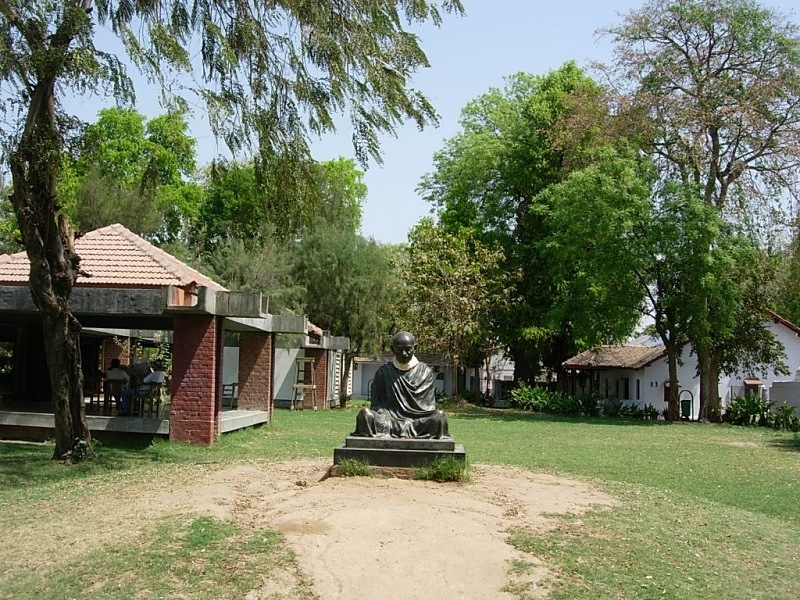
Place Type - Historical
Distance (From Ahmedabad Junction Railway Station): 8 Kms
Trip Duration (Including Travel): 2 Hours
Place Location: At Sabarmati Suburb
Transportation Options: Cab / Auto
Travel Tips: None
At a distance of 8 km from Ahmedabad Junction, Sabarmati Ashram, also known as Gandhi Ashram is located in the Sabarmati suburb of Ahmedabad. Situated on the banks of the River Sabarmati, it is one of the best picnic places near Ahmedabad.
Formerly known as Satyagraha Ashram, the Sabarmati Ashram was established by Mahatma Gandhi in the year 1915 at the Kocharab Bungalow of Jivanlal Desai, a barrister friend of Gandhi. Later on, it was shifted to the banks of Sabarmati River and then it came to be known as 'Sabarmati Ashram'. This was one of the residences of Gandhi, who lived here with his wife, Kasturba Gandhi from 1917 to 1930 CE.
The ashram was served as one of the main centers of the Indian freedom struggle. Gandhiji led the Dandi March or the Salt Satyagraha from this Ashram on 12th March 1930 and had taken a vow that he will not return to Sabarmati Ashram until India gained independence. In gratitude for the substantial impact, Dandi March had on the Indian independence movement, the Indian government has recognized the Ashram as a national monument.
Today it serves as a source of inspiration, guidance, and stands as a monument to Gandhi's life mission and a testimony to others who have fought a similar struggle. The main section of the Ashram is the Gandhi Smarak Sangrahalaya which is a pictorial museum. In 1963, architect Charles Correa designed and built the museum. Along with the museum, this ashram houses a library, auditorium and photo galleries depicting the life of Mahatma Gandhi. Archives of letters written by Gandhi, manuscripts of his articles and films based on India's freedom struggle are housed within the walls of the ashram. The library of the Ashram holds a collection of 35,000 books, all of which are based on the life of Mahatma Gandhi and the Indian freedom movement.
Visitors can explore the ashram in the 90 minutes guided tour that is organized by the Ashram trust. The tour starts with the slide show and takes the tourists to various parts of ashram like Magan Niwas, Upasana Mandir, Hriday Kunj, and Vinoba-Mira Kutir. Other parts like Nandini, Udyog Mandir, Somnath Chattralaya, Teacher's Niwas and Gandhi in Ahmedabad can also be picnic spots near Ahmedabad. The 90 minutes long tour ends after visiting Painting Gallery, 'My life is my message', and Library and Archives.
Timings: 8.30 AM to 6.30 PM
Entry: Free
Swaminarayan Akshardham Temple - Mandir - Gandhinagar
Place Type - Pilgrimage
Distance (From Ahmedabad): 29 Kms
Trip Duration (Including Travel): 1-2 Hours
Place Location: At Gandhinagar
Transportation Options: Bus / Cab / Auto
Travel Tips: None
At a distance of 29 km from Ahmedabad Junction, Swaminarayan Akshardham is a Hindu temple located in Gandhinagar city of Gujarat State. It is one of the most magnificent temples in India and among the top Picnic Places Near Ahmedabad.
Dedicated to Swaminarayan, Akshardham Temple was commissioned by Bochasanwasi Shri Akshar Purushottam Swaminarayan Sanstha (BAPS) after initiation by its promoter, Pramukh Swami Maharaj in 1979. It took 13 years to complete and was inaugurated in 1992. It is a Hindu house of worship and a spiritual and cultural campus dedicated to devotion, education, and unification. A specimen of fine craftsmanship, the Akshardham Temple in Gandhinagar is one of the largest and most prominent temples in the entire state of Gujarat.
Sprawling across an area of 23 acres, the temple complex consists of a splendid shrine, large prayer halls, exhibition halls, verdant garden and research center. Built by using tons of pink stones, this gigantic temple is 108 feet in height, 240 feet long and 131 feet wide. The Akshardham mandir consists of 97 intricately carved pillars, 17 ornate domes, 220 stone beams, 57 stone screens, 3 porticos, and 256 statues of spiritual personalities. The temple is found in the midst of the spacious garden called Sahajanand Van.
The sanctum sanctorum contains a 1.2-ton gold-plated idol of Lord Swaminarayan, the chief deity of Akshardham temple. The 7-foot tall idol of Swaminarayan is in sitting posture with his right hand raised in Abhaya mudra. He is flanked by his disciples Swami Gunatitanand on his right and Swami Gopalanand on his left. There is an attractive display of lights that happens every Saturday and Sundays. This light display heightens the exotic beauty of the Akshardham temple.
There are 5 Exhibition Halls in Akshardham temple and each uses beautiful audiovisual techniques along with life-sized dioramas to understand several themes in Hinduism. The Halls of Sahajanand and Neelkath show the life of Swaminarayan and his philosophy, teachings, etc. A water show named Sat-Chit-Anand is also organized here, which narrates a famous story from the Upanishads. Akshardham also has a research center and library, where only enlisted scholars are allowed.
Timings: 9.30 AM to 7.30 PM, Closed on Monday
Light & Sound Show: 7.30 PM to 8.30 PM
Entry: Free, Rs. 50 per Person for Abhishek, Rs. 60 for Adults & Rs. 40 for Children for Exhibition, and Rs. 90 for Adults & Rs. 60 for Children for Water Show.
Adalaj Stepwell - Adalaj Ni Vav Ahmedabad
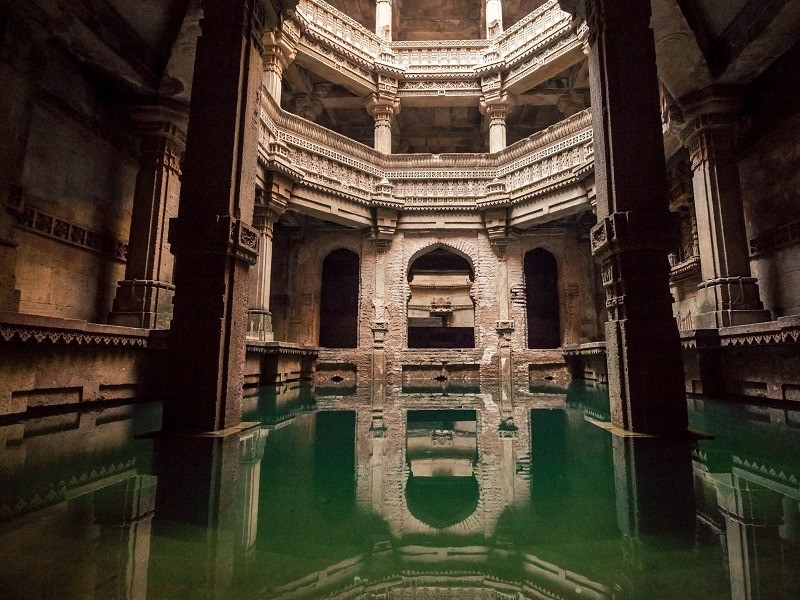
Place Type - Historical
Distance (From Ahmedabad): 21 Kms
Trip Duration (Including Travel): 1-2 Hours
Place Location: At Adalaj Village
Transportation Options: Bus / Cab
Travel Tips: None
At a distance of 21 km from Ahmedabad Junction, Adalaj Stepwell (Adalaj ni Vav), also called Adalaj ni Vav is a stepwell located in the village of Adalaj near Ahmedabad city of Gujarat. It is one of the famous places of heritage in Gujarat and among the best tourist places in Ahmedabad as part of Gujarat tour packages.
Also known as Rudabai Stepwell, Adalaj Stepwell was built in 1499 by Queen Rudabai, wife of Vaghela chief, Veer Singh. According to history, the construction of stepwell was started by King Rana Veer Singh and he has died in a war with King Mahmud Begada unfortunately. Begada fell for the beauty of the widowed Queen Rudabai and asked her to marry him. The Queen agreed to marry Begada on the condition that he completes the construction of the stepwell that was started by her husband. He agreed and started the construction again. When the well got completed, Rani Rudabai jumped into the vav and committed suicide.
The stepwell is built in the Solanki style of architecture with Islamic influence. It consists of five stories, each of which is uniquely designed with beautiful carvings all over the walls and columns. The structure was built along the North-South axis with the entrance from the south. The stepwell is one of its kinds in Gujarat as it has three entrance stairs that lead to the stepped corridor. All three entrances of the stepwell converge at a square platform in the first story, which has an octagonal opening on the top.
The vav is a spectacular example of Indo-Islamic architecture and design. The flower motifs and graphics of Islamic architecture blend very well with the symbols of Hindu and Jain gods carved at various levels of the well. All the walls were carved with some mythological scenes along with everyday scenes of women churning buttermilk, dancers accompanied by musicians, women adorning themselves and a king sitting on a stool. Some interesting features in the carvings include the depiction of Ami Khumbor which symbolizes the pot of water of life, the Kalp Vriksha and the Navagraha or the nine planets.
Timings: 6 AM to 6 PM
Jama Masjid Ahmedabad
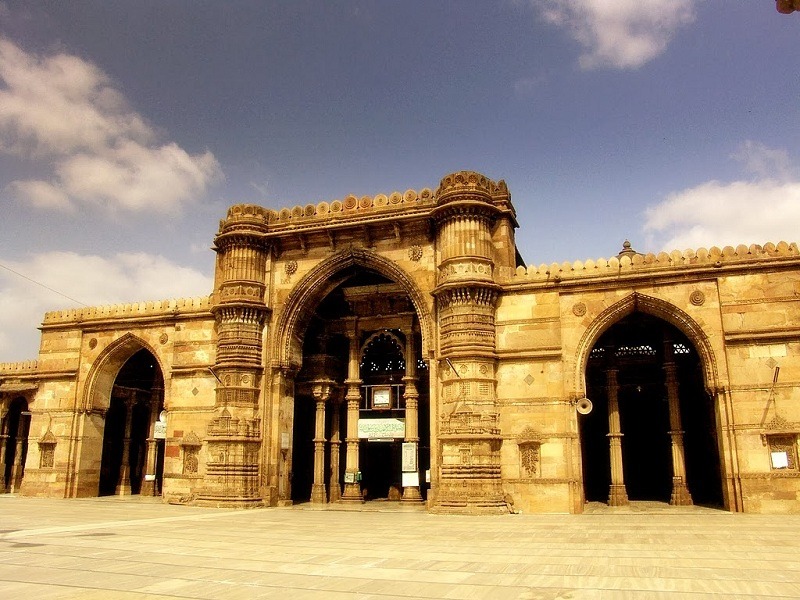
Place Type - Historical, Pilgrimage
Distance (From Ahmedabad Junction Railway Station): 2 Kms
Trip Duration (Including Travel): 30 Mins
Place Location: Old Ahmedabad
Transportation Options: Cab / Walk/Trek
Travel Tips: None
At a distance of 2 km from Ahmedabad Junction, Jama Masjid, literally known as Friday Mosque, is a splendid mosque situated within the old city region of Ahmedabad. Located on the western side of Manek Chowk, it is one of the beautiful mosques in India and among the top Picnic Spot in Ahmedabad.
Also known as Jami or Jumma Mosque, Jama Mosque was built in 1423 AD during the reign of Ahmed Shah I, the founder of the Ahmedabad city. It is considered the largest mosque in the Indian subcontinent built in this period. The mosque was originally intended only for the private use of the sultans. This edifice was built by using materials retrieved from the demolished Hindu and Jain temples. The most striking feature of the construction is its unique meshwork in the main prayer hall, which allows enough illumination into the room without any direct sunlight.
The mosque was built in Indo-Saracenic style and having very attractive carvings on walls and domes. Built with beautiful yellow sandstone, the mosque stands on one side of a huge rectangular platform with three entrances and galleries on three sides. There is a small pond in the middle of the complex which is used for ablutions. Once it had two tall minarets flanking the main arched gateway, however, their top portions collapsed in the devastating earthquake of 1819 AD and now only the base remains.
Also known as Mehrab, the prayer hall is designed using black and white marbles. The main prayer hall has over 260 columns supporting the roof, with its 15 domes. Some of the central domes are carved like lotus flowers, closely related to the typical domes of Jain temples and some of the pillars are carved with the form of a bell hanging on a chain, in reference to the bells that often hang in Hindu temples. There is even a carving of an 'Om' symbol on one of the innermost windows of the prayer hall. The Wall of Prayer, the qibla is beautifully decorated. Pierced stone screens (the 'Jalis') are placed between the two pillars of the central openings.
The Tomb of Sultan Ahmed Shah is located near the eastern entrance of the mosque. It houses the graveyard of three great rulers, Ahmed Shah 1, his son, Mohammed Shah, and his grandson, Qutub-Ud-Din Ahmed Shah II. The tomb is in a square shape with latticed stone windows and four chambers at all four corners with smaller domes. Just across the main road is the Rani-Ka-Hajiro where one can see the tombs of Ahmed Shah's queens.
Visitors should keep their heads covered while entering into the main hall of the mosque. Women are not allowed inside the main hall. This is considered as an offensive act.
Timings: 6 AM to 8 PM
Sabarmati Riverfront Ahmedabad - Amdavad
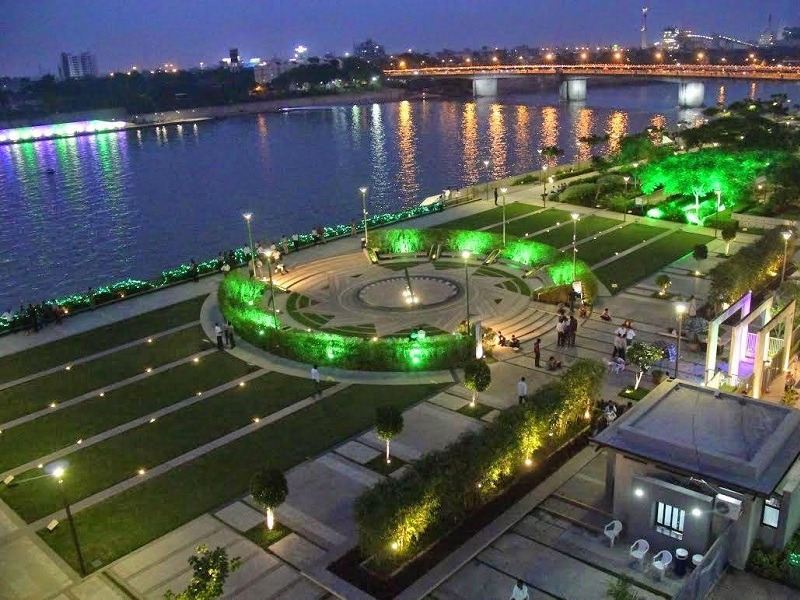
Place Type - Park
Distance (From Ahmedabad Junction Railway Station): 4 Kms
Trip Duration (Including Travel): Half Day Picnic
Place Location: Near Swami Vivekanand Bridge
Transportation Options: Cab / Walk/Trek
Travel Tips: None
At a distance of 4 km from Ahmedabad Junction, Sabarmati Riverfront is a waterfront developed along the banks of the Sabarmati River in Ahmedabad. It is one of the beautiful Picnic Places Near Ahmedabad.
Sabarmati Riverfront is a project undertaken by the Gujarat Government in order to preserve the river and promote tourism. Even though the project was proposed in the 1960s, the construction began in 2005. Since 2012, the waterfront is gradually opened to the public with various facilities. The prime agendas of this project include environment improvement, social infrastructure, and sustainable development.
The main feature of this 11 km long riverfront project is a two-level promenade situated on both sides of the river where the lower level serves only pedestrians and cyclists while the upper level is capable of hosting numerous cultural and educational events, leisure activities, large public parks and plazas and a few areas for commercial and retail development. This is an ideal spot to enjoy a picnic with the family.
It consists of a magnificent walkway over the River Sabarmati. Boat Riding & Evening Walks are the prime activities here. The entire riverfront offers a panoramic view of the city's landscape. Every year in the month of January, the Sabarmati riverfront is decorated to celebrate the International kite festival.
Timings: 9 AM to 9 PM
Entry: Rs. 10 for Adults & Rs. 5 for Children
Boating: Rs. 20 for Person for Motor Boat, Rs. 100 for Person for Speed Boat
Kankaria Lake - Kankaria Talav Ahmedabad
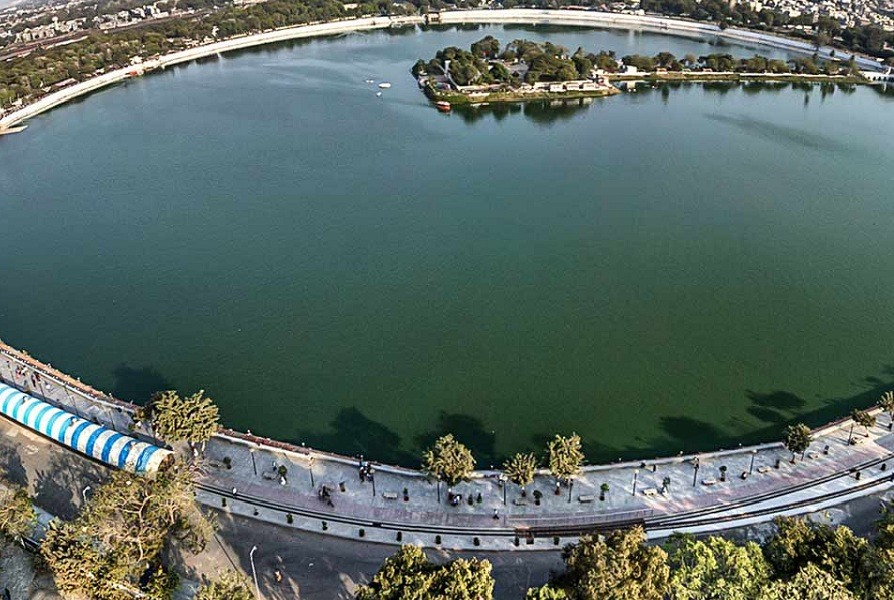
Place Type - Lake - Backwater
Distance (From Ahmedabad Junction Railway Station): 3 Kms
Trip Duration (Including Travel): One Day Picnic Place
Place Location: At Maninagar
Transportation Options: Cab / Auto
Travel Tips: None
At a distance of 3 km from Ahmedabad Junction, Kankaria Lake is a manmade lake situated at the Maninagar area of Ahmedabad. Formerly known as Hauz-e-Qutub, Kankaria Lake is the second largest lake in Ahmedabad and among the popular places to visit in Ahmedabad.
Covering an area of 76 acres, Kankaria Lake was built by Sultan Qutub-ud-Din in the year 1451 AD. It is basically an artificial lake with 34 sides and having a shore length of quarter-mile. The lake has slopes instead of steps at six places to reach water and is covered by square cupolas each raised on 12 pillars.
Lying on the southeastern side of the Ahmedabad city, Kankaria Lake is one of the most favorite picnic spots of the people of Ahmedabad. There is a beautiful island in the center of the lake known as Nagina Wadi or Bagh-e Nagina which houses a small summer palace and a musical fountain with multicolored laser lights that are displayed during the night. An evening walk around the lake when the entire area is lit-up is simply delightful.
A lakefront is developed around it, which has many public attractions such as a Zoo, Toy Train, Kid's City, Balloon Ride, Water Park, Food Stalls, and many entertainment facilities. The lakefront was renovated in 2008. The toy train ride is a wonderful experience to take a round around the lake. Besides, one can also enjoy boating in Kankaria Lake.
One of the main attractions of Kankaria Lake is Kamala Nehru Zoological Park which is widely spread over 31 acres founded by Rueben David in 1951 CE. It was rated as the best zoo in Asia in 1974. It is a treasure of wild animals like tigers, lions, python, anaconda, snakes, elephant, albinos (white), like the rhesus monkey, spotted deer, white blackbuck, chinkara, elephants, emu, jungle babbler, bush-quail and common palm civet. Kankaria Zoo has also recorded in the breeding of rare species in the Zoo like pythons, crocodiles, bearcats and wild asses.
Kankaria Carnival is a week-long festival held at the lake premises in the last week of December every year. Many cultural, art and social activities are organized during the carnival. Some of the fun events and adventures included are- Magic Show, Rangoli-making competition, debate, essay or painting competitions, dog show, scuba-diving, laser show, and gymnastics.
Timings: 9 AM to 10 PM, Closed on Monday
Zoo Timings: 9 AM - 5.30 PM, closed on Monday
Entry: Rs. 20 for Adults & Rs. 10 for Children for Lake and Rs. 20 for Adults & Rs. 10 for Children for Zoo, Rs. 25 for Adults & Rs. 10 for Children for Toy Train
Bhadra Fort - Bhadra no Kilo Ahmedabad
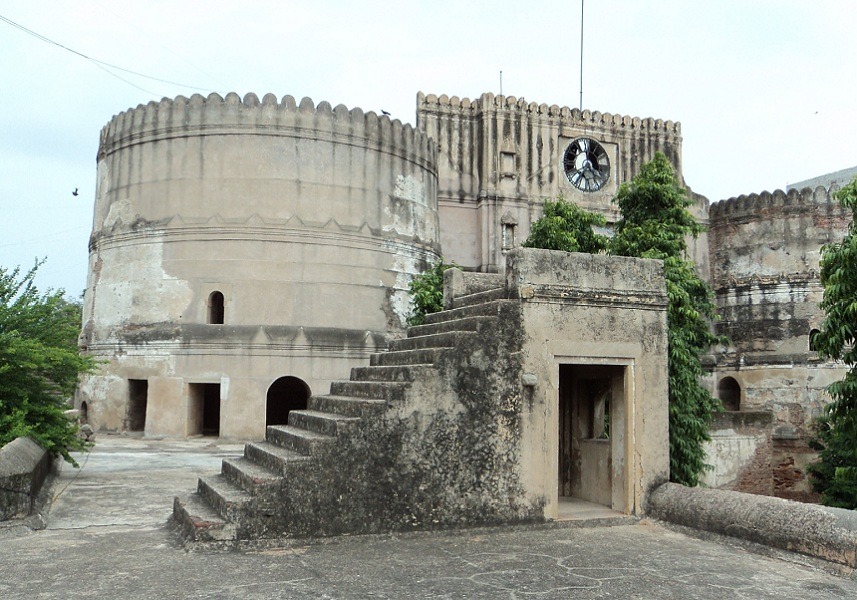
Place Type - Historical
Distance (From Ahmedabad Junction Railway Station): 2.5 Kms
Trip Duration (Including Travel): 1 Hour
Place Location: Old Ahmedabad
Transportation Options: Cab / Auto
Travel Tips: None
At a distance of 2.5 km from Ahmedabad Junction, Bhadra Fort is an ancient fort situated on the east bank of Sabarmati River in Ahmedabad city of Gujarat. It is one of the historical places in Gujarat and among the most popular Ahmedabad Tourist Places.
Bhadra Fort (Bhadra No Kilo) was built in 1411 AD by Sultan Ahmad Shah I, the founder of Ahmedabad city. In the year 1573, Bhadra Fort was taken over by the Mughal emperor Akbar. Under the rule of Mughals, Ahmedabad became the leading center of textiles in Gujarat. Peshwas and Gaekwads jointly ended the Mughal rule and established the Maratha Empire in 1583 CE. The British defeated the Marathas in the war held between 1775 AD and 1782 AD but they gave back the fort after signing a treaty with the Marathas. The British captured the fort in 1817 CE and was used as a jail till independence.
The fort was named so because of the presence of Bhadra Kali Temple which was built during the reign of the Marathas. It is also said that Sultan Ahmad Shah built the Bhadra gate for entering the fort and due to this, the fort is called Bhadra fort. The fort was also known as Arak Fort as described in Mirat-i-Ahmadi.
Encompassing an area of about 43 acres, the fort was built in Indo-Saracenic style. This square-shaped fort had a fortified city wall with 14 towers, eight gates, and two large openings. The fort complex includes the beautiful Nagina Baug, a beautiful palace, Ahmed Shah's Mosque, a temple for goddess Bhadra Kali and the famous Teen Darwaza. Most part of the fort has been built with deep red colored stones. The palace inside the fort has ornate arches and heavily embellished balconies, a testament to the brilliance of Mughal architecture.
Ahmad Shah Mosque was built by Ahmad Shah in 1414 AD. The mosque was used by the royal people for offering prayers. The outer wall of the mosque is plain having pointed arches. There are five large domes along with small domes that are beautifully ornamented and are supported by pillars. It is considered as the oldest mosque of Ahmedabad.
Currently, the fort houses several government offices like ASI, post office, etc.
Timings: 9 AM to 5 PM
Entry: Free
Kalupur Swaminarayan Temple - Kalupur Swaminarayan Mandir Ahmedabad
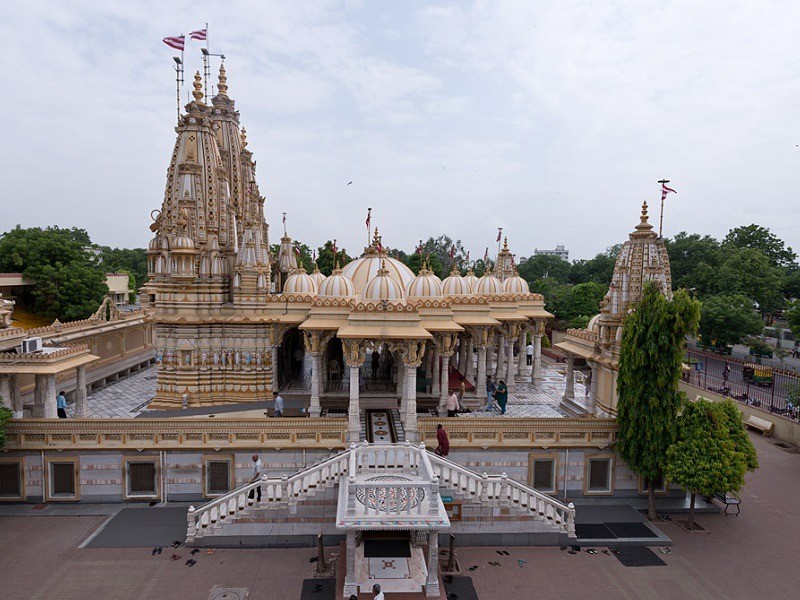
Place Type - Pilgrimage
Distance (From Ahmedabad Junction Railway Station): 2 Kms
Trip Duration (Including Travel): 30 Mins - 1 Hr
Place Location: At Kalupur
Transportation Options: Cab / Auto
Travel Tips: None
At a distance of 2 km from Ahmedabad Junction, Swaminarayan Temple is a Hindu temple situated at the Kalupur area of Ahmedabad. It is one of the popular places of pilgrimage in Gujarat and among the best places to visit in Ahmedabad.
Dedicated to Lord NarNarayan, Kalupur Swaminarayan Temple (Kalupur nu Swaminarayan Mandir Ahmedabad) is the first and foremost temple of the Swaminarayan sect. Swaminarayan Sampraday is categorized into two sections namely the Nar Narayan Dev Gadi and the Lakshmi Narayan Dev Gadi. Swaminarayan Temple at Kalupur serves as the headquarters of the Nar Narayan Dev Gadi. According to history, the land for construction of this temple was given by the British Imperial Government in 1822 CE. The task of constructing this temple was hand over to Anandanand Swami by Swaminarayan.
The structure of the temple is mesmerizing and has been designed like a mansion. The temple is carved in Burmese teak, and every arch and bracket is painted with bright colors. It is adorned with brilliantly ornamented domes and galleries. The interiors and exteriors of the temple have been adorned with the typical Gujarati designs that depict different aspects of the Gujarati culture and lifestyle.
The sanctum sanctorum of the temple houses the image of Narayan Dev made of marble. The idol of Radhakrishna Dev is set on his right. To the left of the main deity are the images of Dharmdev, Bhakti Mata and Harikrishna. There are several idols installed by Swaminarayan himself, as well as a display of some of his personal items and sculptures. On the southern side of the temple, there are nine tombs, which are more popularly known as 'Nau Gaz Pir' or 'Nine Yard Saints'.
A historic walk, organized by Ahmedabad Municipal Corporation, starts from this auspicious Swaminarayan temple which navigates through 20 historic sites before calling it off at the Jama Masjid.
Timings: 6 AM to 7 PM
ISKCON Radha Krishna Temple - ISKON Radha Krishna Mandir Ahmedabad
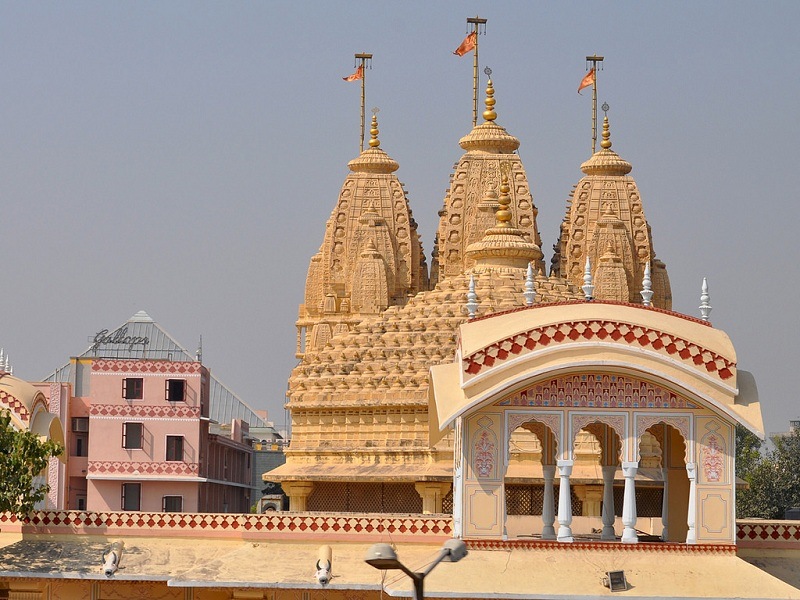
Distance (From Ahmedabad Junction Railway Station): 13 Kms
Trip Duration (Including Travel): 1-2 Hours
Place Location: On Sarkhej-Gandhinagar Highway
Transportation Options: Cab / Auto
Travel Tips: None
At a distance of 13 km from Ahmedabad Junction, ISKCON Temple is a Hindu temple located on Sarkhej-Gandhinagar Highway in Ahmedabad, Gujarat. Also known as Sri Radha Govind Dham, it is one of the top places of pilgrimage in Gujarat and among the famous places to visit in Ahmedabad.
ISKCON Temple (ISKON Radha Krishna nu Mandir) in Ahmedabad is dedicated to Lord Krishna and his beloved lover Radha. The temple was opened in 1997 on the orders of A. C. Bhakti Vedanta Swami Prabhupada, the founder of the ISKCON Society. The temple has much significance as it is still considered as the most popular temple in Ahmedabad. The idols of Lord Krishna & Radharani are attractive and many people come here for worshipping Lord Krishna to fulfill their needs.
Sprawling over an area of 4 acres, the architecture of the temple is a blend of Gujarati-Sompura and Rajasthani-Khamira style. The temple features the largest temple rooms in India, which can accommodate around 4000 devotees. One can see intricate marble work, beautiful murals, gorgeous columns, exquisite marble floors and designer walls at the temple. The temple houses the deities of Radha - Govinda, Nitai-Gauri, Rama Sita Lakshman Hanuman, Jagannath Baldev, Sri Nathji, Subhadraji and idols of Srila Prabhupada and Srila Bhaktisiddhanta Saraswati.
The temple complex also has a library, restaurant, hostel, a meditation room, etc. The premises of the temple vibrate with the chants of Hare Krishna during prayer sessions. The followers hold sessions in institutes, corporates, etc., to teach the techniques of spiritualizing daily life. The temple is well maintained and extremely neat and clean. Janmashtami and Nand Mahotsav are the two important festivals celebrated here with great pomp and fervor.
Timings: 4.30 AM to 1 PM & 4 PM to 9 PM
Sardar Vallabhbhai Patel National Memorial Ahmedabad - Gujarat
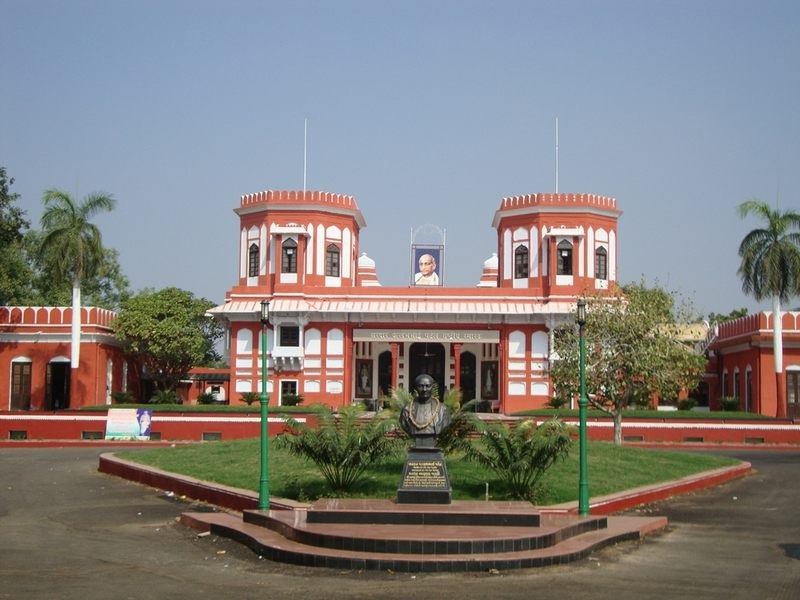
Place Type - Museum, Gallary
Distance (From Ahmedabad Junction Railway Station): 6 Kms
Trip Duration (Including Travel): 30 Mins
Place Location: In Shahibaug Locality
Transportation Options: Cab / Auto
Travel Tips: None
At a distance of 6 km from Ahmedabad Junction, Sardar Vallabhbhai Patel National Memorial is a museum and exhibition center situated in Shahibaug locality of Ahmedabad, Gujarat. Dedicated to Sardar Vallabhbhai Patel, it is one of the most famous museums in Gujarat and among the best places to experience Ahmedabad Tourism.
Sardar Vallabhbhai Patel National Memorial Museum is housed in the Moti Shahi Mahal, which was constructed between 1618 and 1622 for Mughal Emperor Shah Jahan. The building was later used as a British cantonment to house the senior officials. In 1878, the great Bengali poet Rabindranath Tagore stayed here and this building served as an inspiration behind his story The Hungry Stones. This palace became the Raj Bhavan, the official residence of the Governor of Gujarat from 1960 to 1978 and was transformed into a national memorial dedicated to Sardar Vallabhbhai Patel in the year 1978. Later in the year 2013, the infrastructure of the museum was enhanced with the latest technology for a more interactive experience.
The museum is located on the ground floor, covering the central hall and four adjacent rooms. Exhibiting more than 10,000 specimens of art and craft, the museum is known as the best art museum of Gujarat that houses Sardar Patel's belongings, his life-size portrait with family and friends. Visitors can also find the biography of Sardar Patel in the museum, which contains a detailed description of all the phases of his life. A major attraction of the Sardar Patel National Memorial Museum is the national flag that was designed by the Indian National Congress in 1930 -1931.
The museum is equipped with state-of-the-art facilities like multimedia halls, LCD displays, jail zone, multi-touch tablets, etc. The highlight of the museum is its 3D sound, light and laser show that narrates the story of our motherland, India. The story outlines the Vedic period, the Mughal era, the British domination, and the freedom struggle of India. The show is a salutation to all our freedom fighters and martyrs. There is a lush green garden with beautiful water bodies attracting animals like monkeys and peacocks in the exteriors of the museum.
Timings: 9.30 AM to 5 PM, Closed on Monday
Entry: Rs. 20 for Adults & Rs. 10 for Children for Museum, Rs. 30 for Adults & Rs. 10 for Children for 3D Show
3D Show Timings: 7 PM to 7.45 PM (Sat & Sun only)
Entry Fee: Rs.30 for adults & Rs.10 for children
Julta Minar - Julta Minara Masjid Ahmedabad - Shaking Minarets
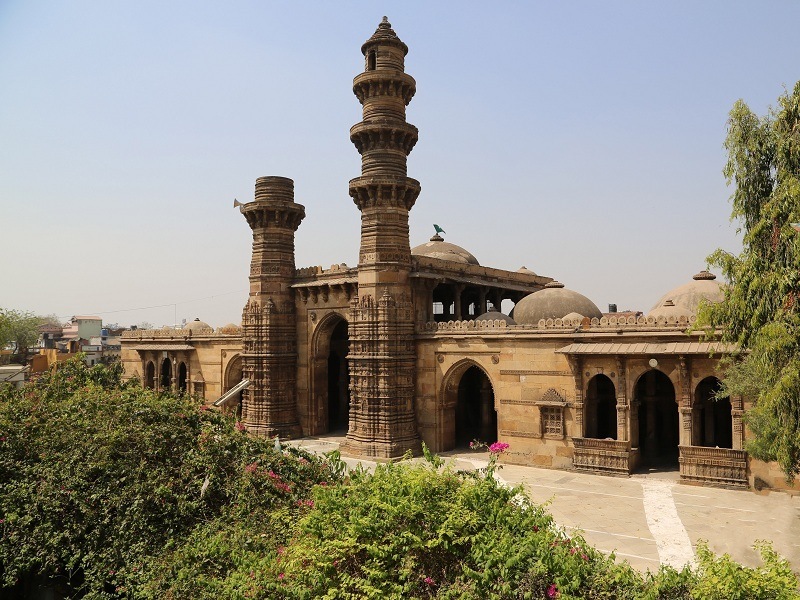
Distance (From Ahmedabad Junction Railway Station): 1 Kms
Trip Duration (Including Travel): 30 Mins
Place Location: At Sidi Bashir Mosque
Transportation Options: Cab / Walk/Trek
Travel Tips: None
At a distance of 1 km from Ahmedabad Junction, Jhulta Minar is an ancient monument located near Ahmedabad Junction Railway Station in Ahmedabad, Gujarat. This is one of the unique monuments in the world and among the must-visit tourist attractions in Ahmedabad.
Also known as the Shaking Minarets, Jhulta Minara Masjid History is one of the most intriguing architectural wonders that the world has ever seen. They are playful but still an unsolvable mystery. What makes the minarets unique is if one of the minarets is shaken then the other minaret shakes within a few seconds, while the connecting passage doesn't transmit any movements or vibrations. Many architects and historians have tried to understand the physics and logic behind the unrelated movements of the minarets.
There are two well-known pairs of Shaking Minarets in Ahmedabad, one located opposite the Sarangpur Darwaja and the other near the Kalupur Railway Station Area. The one near Sarangpur Darwaja is within the vicinity of the Sidi Bashir Mosque built in 1452 AD by Sidi Bashir, a slave of Sultan Ahmed Shah. The mosque was later torn down during a Gujarat Sultanate war. The minarets were to be the entrance of the mosque. They are constructed in a Gothic Muslim manner with Rajputana influences. The minarets are 34 meters long and have three stories. They also had well-balanced balconies made of stone. The sole purpose of these balconies is to border the minaret. A stairway runs in the middle of the minaret in order to reach the top.
The minarets were designed with such an intention that applying a small amount of force on the upper arch of the mosque will lead to the shaking of every minaret simultaneously. It is hence believed that the minarets were constructed with the main purpose of avoiding any damage to the mosque in the case of a natural disaster. The minarets are able to withstand fast-moving trains passing close by. Unfortunately, due to the fear of further damaging this architectural marvel, the doors of the minarets have been locked and entry to the minaret is prohibited.
The other set of minarets near the Railway Station is taller in height. However, these are not in a very good condition as it is believed that the British had dismantled them to understand the cause of vibrations. They could not resolve the engineering and it was not possible to put them back in their original condition. Demonstrations of the minarets shaking or vibrating are not carried out anymore.
Timings: 9 AM to 5 PM
Calico Museum Of Textiles Ahmedabad
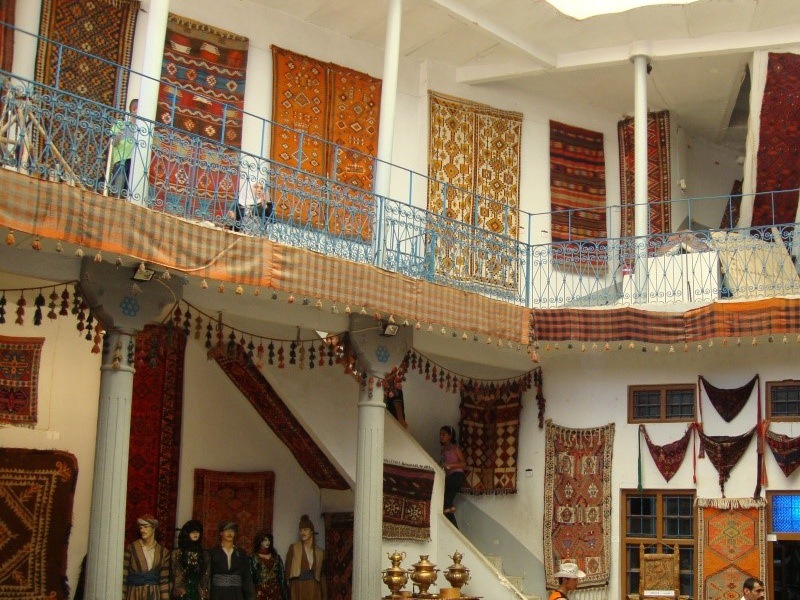
Place Type - Museum, Gallary
Distance (From Ahmedabad Junction Railway Station): 5 Kms
Trip Duration (Including Travel): 30 Mins
Place Location: In Shahibaug Locality
Transportation Options: Cab / Walk/Trek
Travel Tips: None
At a distance of 5 km from Ahmedabad Junction, Calico Museum of Textiles is a museum situated in the Shahibaug area of Ahmedabad, Gujarat. It is one of the popular textile museums in India and among the top places to visit in Ahmedabad.
The museum was founded in 1949 by industrialist Gautam Sarabhai and his sister Gira Sarabhai. Originally, the museum was housed at the Calico Mills in the heart of the textile industry. Later the museum was shifted to Sarabhai House in 1983 due to an increasing number of exhibits. The museum has played an important role in determining the curriculum taught in the textile designing courses at the prestigious National Institute of Design, Ahmedabad. The museum is managed by Sarabhai Foundation.
The museum exhibits an enormous collection of fabrics, which are collected from all over the country. Bordered by the lush green gardens and fountains, the museum has two separate sections for textiles, the religious clothing section, and the historic textiles section. The historic textile section displays the court textiles used by the Mughal and local rulers of the 15th to 19th centuries while the religious section has exhibits on ritual art and sculpture, temple hangings, miniature paintings, South Indian bronzes, Jain art and sculpture, and furniture and crafts.
There are also textile techniques galleries and a library which has a sizable number of books related to textile and art. Also, museum authorities keep on organizing a workshop for the students and researchers to understand the textile industry in a better manner. The items on display are well protected by the museum authorities. The textiles are protected from dust, air pollution and fluctuations in temperatures by the trees around the museum complex.
A single guided tour is offered each day by the museum and the entry is restricted to 30 visitors. The guided tour starts at 10.45 AM and visitors are not allowed inside after 11 AM. Advance booking is mandatory for this museum entry.
Timings: 10.30 AM to 12.30 PM, Closed on Wednesdays & Public Holidays
Entry: Free
Sidi Sayed Jali Mosque - Sidi Sayed Ni Jali Ahmedabad
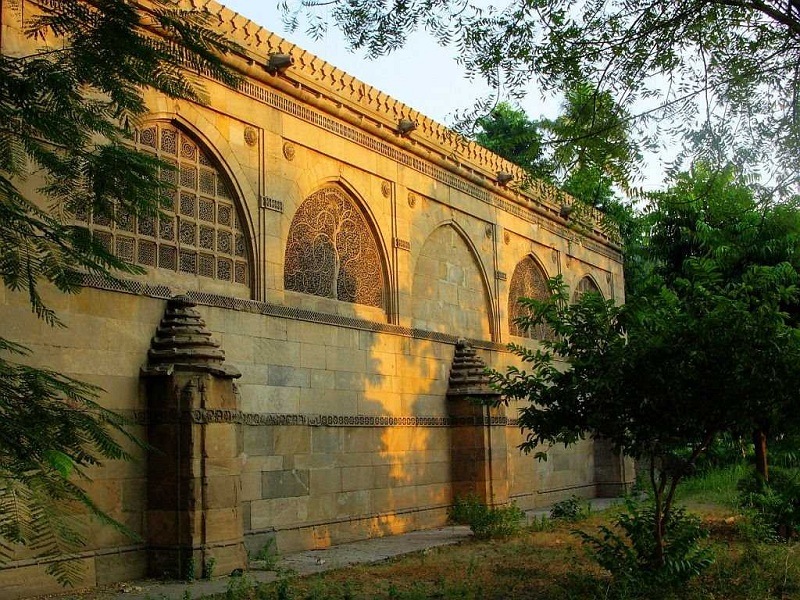
Distance (From Ahmedabad Junction Railway Station): 3 Kms
Trip Duration (Including Travel): 30 Mins
Place Location: Near Lal Darwaza
Transportation Options: Cab / Walk/Trek
Travel Tips: None
At a distance of 3 km from Ahmedabad Junction, Sidi Sayed Mosque (Sidi Saiyad ni Jali Ahmedabad, Gujarat) is an old mosque situated near Lal Darwaza in Ahmedabad city of Gujarat. Popularly known as Sidi Saiyyed ni Jali, it is one of the well-known mosques in Ahmedabad and among the best places to visit in Ahmedabad.
The mosque was built in 1573 CE by Sidi Sayed during the reign of Sultan Muzaffar Shah III, the last ruler of Gujarat. He came to Gujarat from Yemen and later served Sultan Nasir-ud-Din Mahmud III. According to history, the mosque was built in the last year of the existence of the Sultanate of Gujarat, before the Mughals took over the city. Earlier, the Sidi Saiyyed Mosque was used as a government office during the British Rule, but now it is under the care of the Archaeological Survey of India (ASI).
The Sidi Saiyyed Mosque is built with yellow sandstone in the Indo-Islamic style of architecture. The mosque is famous for its beautifully carved ten stone latticework windows (jalis) on the side and rear arches. The rear wall is filled with square stone pierced panels in geometrical designs. The two bays flanking in the central walkway have reticulated stone slabs carved in designs of intertwined trees and foliage with a palm motif.
The most exquisitely carved window is known as the 'Tree of Life', and is a resplendent verse to the artistic genius of its makers. This is the unofficial symbol of the city of Ahmedabad and also the inspiration for the design of the logo of the Indian Institute of Management, Ahmedabad.
Timings: 7 AM to 6 PM
Sarkhej Roza Ahmedabad
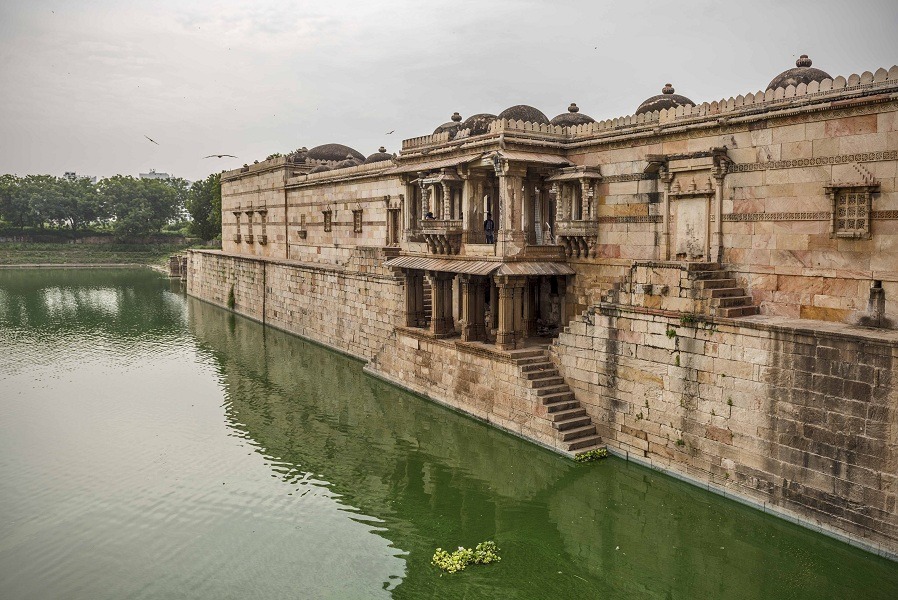
Distance (From Ahmedabad Junction Railway Station): 12 Kms
Trip Duration (Including Travel): 1 Hour
Place Location: At Makarba Village
Transportation Options: Cab
Travel Tips: None
At a distance of 12 km from Ahmedabad Junction, Sarkhej Roza is a mosque and tomb complex located in Makarba village of Ahmedabad in Gujarat. It is one of the popular historical places in Gujarat and among the best places to experience Ahmedabad Tourism.
Sarkhej Roza is an elegant architectural edifice comprising various buildings grouped around a stepped tank called Sarkhej Pond. These include the tomb of Ahmed Khattu Ganj Baksh, a mosque, the tombs of Mahmud Shah Begada and his queen, and a palace. It is also known as Acropolis of Ahmedabad as its design is often compared to the famous Acropolis of Athens.
According to history, Sarkhej Roza was a prominent center of Sufi culture and where the Sufi saint, Ganj Baksh lived. It was on the saint's suggestion that Sultan Ahmed Shah set up his capital on the banks of Sabarmati River, a few miles away from Sarkhej. After the death of the saint in 1445 CE, Mohammed Shah has ordered to build a mausoleum in his remembrance together with a mosque. Qutub-ud-Din Ahmed Shah, the successor of Mohammed Shah has completed the construction of both the structures in 1451 AD. Sultan Mahmud Begada was fond of the place and expanded the complex greatly by building a small mosque, a mausoleum and a palace along with Sarkhej Pond.
Started with 72 acres of land currently, Sarkhej Roza stands on just 34 acres of land due to local encroachments. The architectural style of Sarkhej Roza is an elegant mix of Islamic and Hindu architectures, evident from its composite Indo-Saracenic style. The main Roza or the mausoleum of Saint Sheikh Ganj Baksh Khattu is at the center of the complex. This is the biggest of all the Roza in Gujarat. The tomb of the saint is supported by thirteen pillars and provides a peaceful atmosphere. Along with the tomb, the mosque inside this structure has a spacious courtyard, colonnades and prayer halls.
Beyond the Ganj, Baksh mausoleum is a courtyard with a mosque only slightly smaller than the Jama Mosque. Across the courtyard on the left are two mausoleums with a connecting porch, the east mausoleum containing the tombs of Mahmud Begada and his son Sultan Muzaffar II, and the west, the tomb of Rajabai, Muzaffar's queen. The royal tomb of Mahmud Begada and the majestic mausoleum stands as an architectural marvel. The tomb is huge and also elegantly designed with latticework. Covering an area of about 17 acres, the Sarkhej Lake is oblong in shape and is surrounded by flights of stone steps. Across the lake, one can see the ruined buildings of Mahmud Begada's palace and harem.
Note: Women are not allowed in the main hall of dargah and men are not allowed without full pants.
Timings: 9 AM to 6 PM
Entry: Free
Vaishnodevi Temple - Vaishnodevi Mandir Ahmedabad
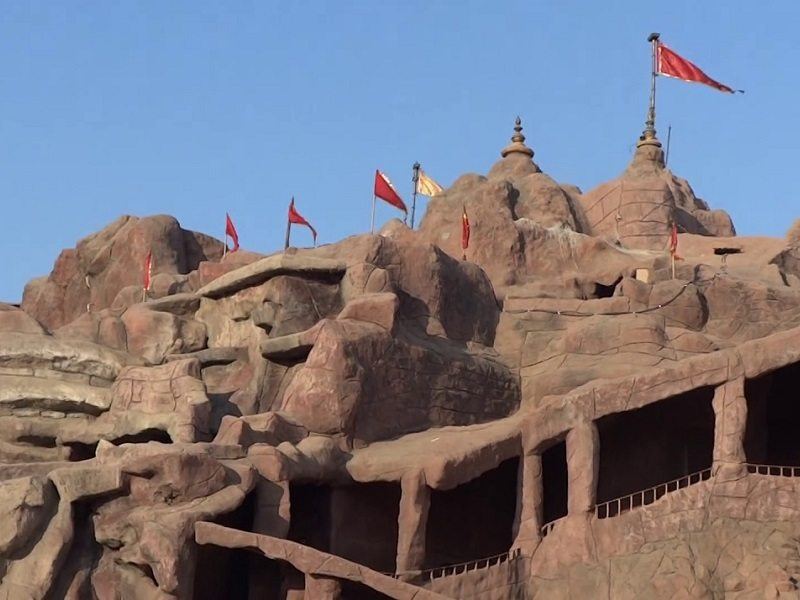
Distance (From Ahmedabad): 19 Kms
Trip Duration (Including Travel): 1-2 Hours
Place Location: Near Khodiyar Village
Transportation Options: Cab / Auto
Travel Tips: None
At a distance of 19 km from Ahmedabad Junction, Vaishnodevi Temple is a Hindu temple situated on Sarkhej - Gandhinagar Highway in Ahmedabad. It is one of the most important places of pilgrimage in Ahmedabad and among the best places to experience Ahmedabad Tourism.
Built-in 2007, Vaishnodevi Temple in Ahmedabad is dedicated to Goddess Vaishnodevi, an incarnation of Goddess Durga. The temple is a true replica of the original Vaishnodevi temple of Jammu Kashmir and satisfies the quest of devotees seeking a pilgrimage to the sacred Hindu temple.
This temple even has the look of the original one and is built on a mock hill instead of the high peaks in Jammu. This circular shaped manmade hill made out of yellow sandstone. The temple interiors have beautiful carvings and many sculptures of Gods and Goddesses. Pilgrims have to go through the manmade hill to reach the main shrine located at the top of the hill. There are also sprawling gardens surrounding this temple.
As the temple is dedicated to Goddess Vaishnodevi, Navratri is celebrated with great pomp and fervor. The temple is decorated beautifully and attracts huge crowds during Navratri.
Timings: 5 AM to 10 PM
Shree Camp Hanumanji Mandir Ahmedabad - Camp Hanumanji Temple
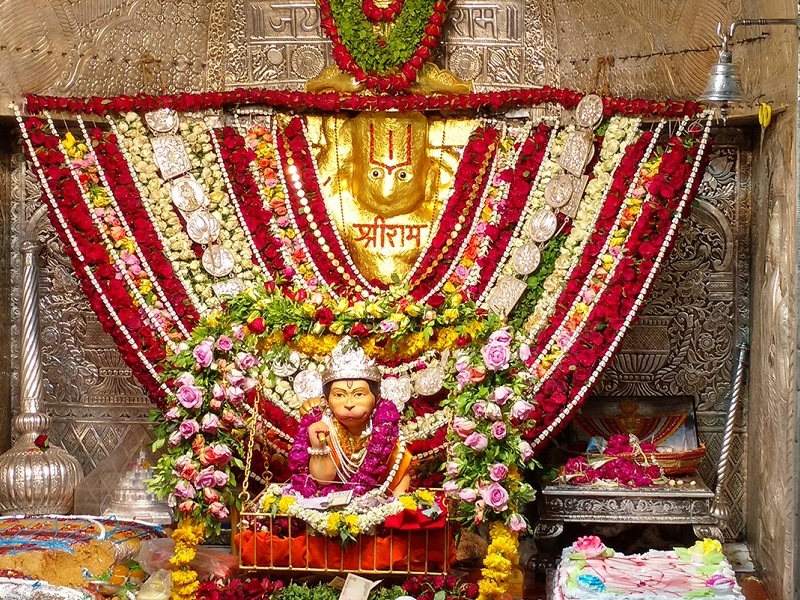
Distance (From Ahmedabad Junction Railway Station): 7 Kms
Trip Duration (Including Travel): 1 Hour
Place Location: At Cantonment Area
Transportation Options: Cab / Auto
Travel Tips: None
At a distance of 7 km from Ahmedabad Junction, Camp Hanuman Temple is a Hindu temple situated in the Cantonment area of Ahmedabad. It is one of the biggest Hanuman Temples in India and among the popular places of pilgrimage in Ahmedabad.
Dedicated to Hanuman, the temple was established more than a hundred years ago by Pandit Gajanan Prasad. According to legend, Shree Hanuman was a military leader of the monkey army from Kishkinda, who aided Lord Rama in his quest to retrieve his kidnapped wife Sita from the demon king Ravana in the Hindu epic tale Ramayana, written by the Hindu sage Valmiki.
The main sanctum sanctorum of the temple houses a gold plated statue of Lord Hanuman. The weapon of Lord Hanuman, a mace, is also placed near the idol. The temple walls are adorned with writings of the name of Lord Rama. People come here from faraway places to seek the blessings of Hanuman and to get rid of their various problems. The first woman prime minister, Smt. Indira Gandhi visited Shri Camp Hanumanji Temple in 1980 after winning the elections.
The temple is open for worship to people from all walks of life. There will be a huge crowd every Tuesdays and Saturdays as these are considered to be the most auspicious days to worship the Lord. On Hanuman Jayanti, a big procession is taken out and thousands of people attend the procession every year.
Visitors need to park their vehicles outside the main gate and then walk around half a kilometer inside the Cantonment area to reach the temple. Senior citizens can take battery-operated shuttle service to reach the temple from the main gate.
Timings: 6.30 AM to 5.30 PM
Dada Harir Ni Vav Ahmedabad - Dada Harir Stepwell
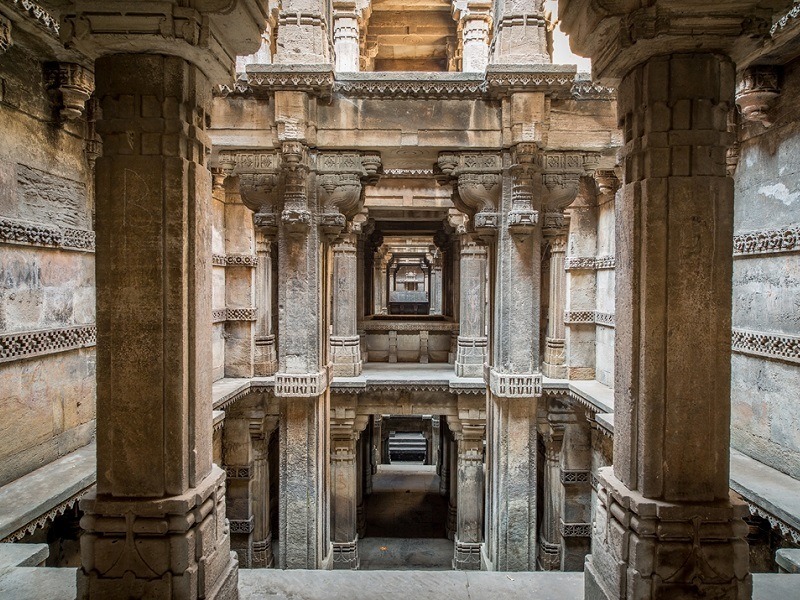
Distance (From Ahmedabad Junction Railway Station): 2.5 Kms
Trip Duration (Including Travel): 30 Mins
Place Location: At Aswara Area
Transportation Options: Cab / Auto
Travel Tips: None
At a distance of 2.5 km from Ahmedabad Junction, Dada Harir Vav is a stepwell situated in the Aswara area of Ahmedabad, Gujarat. Popularly known as Dada Hari ni Vav, it is one of the beautiful step wells in Gujarat and among the popular places of heritage in Ahmedabad.
Dada Harir Stepwell was built in 1485 by Dhai Harir, a household lady of Mahmud Begada according to the Persian inscription in the stepwell. She was the superintendent of the royal harem. The well bears two inscriptions, one in Sanskrit on the south, and one in Arabic on the north wall, of the first gallery. Like most step-wells, this vav is also designed to store water and also a resting place for travelers. The well lies just behind the tomb of Dada Hari.
This seven-story stepwell has a spiral stairway that takes visitors to each story. The walls and pillars are detailed intricately with delicate carvings and floral sculptures. The decorated arches and ornate columns showcase a fine blend of traditional Muslim architecture and Hindu sculpture skills. There are certain Arabic and Sanskrit scriptures engraved on the walls which are still visible today. The well at the bottom level is in the shape of an octagon.
Timings: 9 AM to 5 PM
Science City Ahmedabad Gujarat
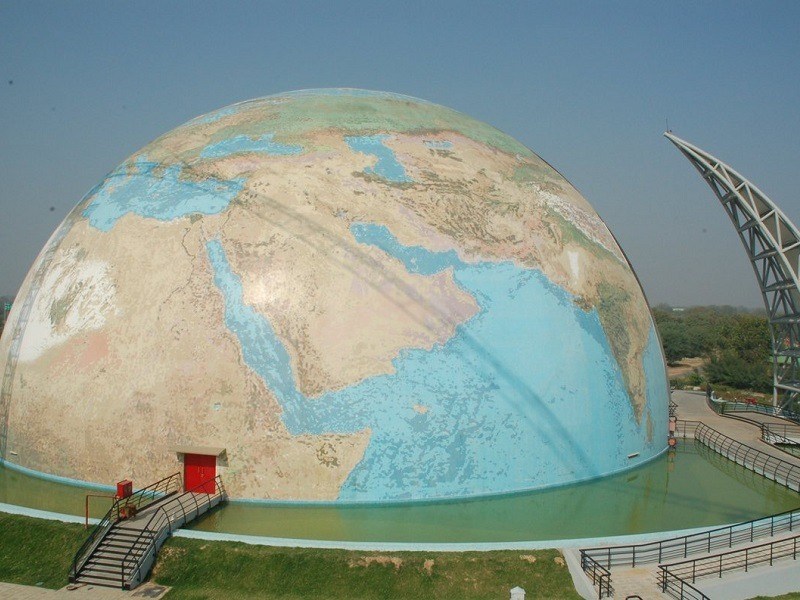
Distance (From Ahmedabad Junction Railway Station): 15 Kms
Trip Duration (Including Travel): 2-3 Hours
Place Location: Near Hebatpur
Transportation Options: Cab / Auto
Travel Tips: None
At a distance of 15 km from Ahmedabad Junction, Science City is an educational center located in Hebatpur locality of Ahmedabad, Gujarat. Focused on Science and Technology, it is one of the best places to visit in Ahmedabad.
The Science City was set up in 2001 with a motive to spread awareness about the progression of science and its application in human life. Ventured by the state government of Gujarat, this science city is a blend of education and entertainment. It showcases contemporary and imaginative exhibits, working models, virtual reality, activity corners, labs and live demonstrations to provide an understanding of science and technology to the common man.
Covering an area of more than 107 hectares, the Gujarat Science City houses an IMAX 3D theatre, an energy park, a hall of science, Planet Earth, an amphitheater, Life Science Park and musical fountains. With a variety of working exhibits, visitors discover science by themselves in the Hall of Science. They can turn handles, press buttons, look through peepholes, perform fascinating experiments and be amazed at their own capability of making things work. Interactive and educative exhibits of Hall of Space give the visitor an insight into the working of satellites, mobile telephone, Internet and the application and usage of these technologies in real life.
The Planet Earth pavilion will depict the live experiences of various natural disasters, disaster management with various hands-on and minds-on exhibits and activities. The main section of the Planet Earth pavilion includes Underground Coal Mine, Disaster of Bhuj Earth Quake, Dynamotion, Disaster Management, Children Activity Corner, Life in Water, and many more. The Musical Fountain at science city is claimed to be the Asia's largest one. It has more than 20 kinds of water styles including a floating fountain, seagulls, chasing waves, peacocks, swinging, and flower baskets. At the IMAX 3D Theatre, there are several shows throughout the day, which start at 2.30 PM and last till 7.30 PM. Some Thrill Rides are also available at the Science Centre.
The center also organizes a program called Vacation Training Program on Bioresources for school children with the help of government funds to encourage students regarding Bioresources. It is a month-long program for students who gave their SSC exams, each from every district of the state.
Timings: 10. 30 AM to 9 PM
Musical Fountain: 6.30 PM to 7.30 PM
Manek Chowk Ahmedabad
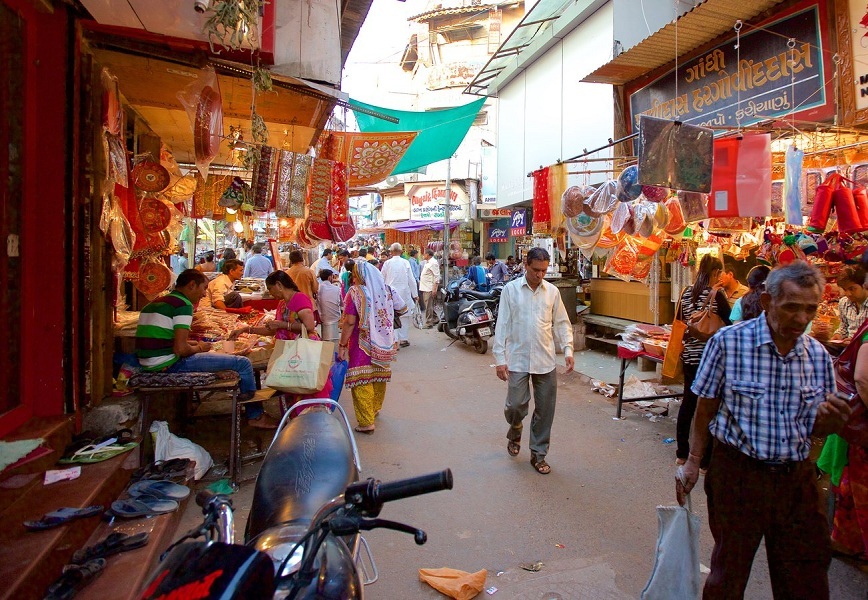
Distance (From Ahmedabad Junction Railway Station): 2 Kms
Trip Duration (Including Travel): 2 Hours
Place Location: Near Jama Masjid
Transportation Options: Cab / Walk/Trek
Travel Tips: None
At a distance of 2 km from Ahmedabad Junction, Manek Chowk is a bustling market situated in old Ahmedabad in the state of Gujarat. Surrounded by historical places, it is considered as the second biggest market in India and among the best places to visit in Ahmedabad.
Named after the Saint Maneknath, Manek Chowk acts as a vegetable market in the morning, a jewelry market in noon and the street food market at night. This place has an average annual turnover of 3 million rupees. It is widely known for its street food stalls that start emerging around 9 PM and continue till midnight. The food is also very tasty and economical. Locals consider it a suitable place for hanging out with friends and family.
The Morning Vegetable Market is suitable for the people who are in search of fresh fruits and vegetables. Tourists who want to cook their own food can purchase fresh produce at really affordable rates. In the afternoon, Manek Chowk is a hub of gold and silver jewelry. There are a lot of jewelry stores as well in the area, where one can purchase traditional jewelry and other accessories. Rani No Hajiro is a perfect location for purchasing women's apparel and accessories. Here, one can find a variety of designs, colors, patterns, and handwork to choose from whether it's the traditional Chaniya Choli, Sarees, Ghagras or Kurtas and Kurtis.
The Night Market is the place for Foodies. It is one of the few food-street starts in the evening and stays open till late at night. One can taste some most delicious food items like Bhajipau, Dosa, Sandwiches and many more local cuisines here. But the most popular is Pavbhaji, special Amdavadi sandwiches, and Kulfi. Besides, one can also visit some historical structures like Jama Masjid and Baba Maneknath Temple. Best Tourist Places Near Vadodara.
Timings: 6 AM - 11 PM
Nalsarovar Bird Sanctuary - Nal Sarovar Pakshi Abhyaran Ahmedabad

Distance (From Ahmedabad): 69 Kms
Trip Duration (Including Travel): 4 Hours/Half Day
Place Location: Near Nalsarovar
Transportation Options: Bus / Cab
Travel Tips: None
At a distance of 41 km from Sanand and 69 km from Ahmedabad, Nalsarovar Bird Sanctuary (Nal Sarovar Pakshi Abhyaran) is a protected bird sanctuary situated at Nalsarovar village in Gujarat. Nalsarovar is one of the largest wetland bird sanctuaries in India and among the prime attractions of Ahmedabad Tourism.
The Nalsarovar Lake (Nal Sarovar Talav Ahmedabad) and the wetlands around it were declared as a bird sanctuary in 1969. Covering an area of 120.82 Sq.km, it is a serene marshland with shallow waters which contains 36 small islands. It has been identified as one of the 15 important wetlands of India by the National Committee on Wetlands for intensive conservation. Lying in an area between Central Gujarat and East Saurashtra, it represents a sea link that once existed between the Little Rann and the Gulf of Khambat. The lake gets filled with water that drains from the adjoining Surendranagar and Ahmedabad districts in the monsoon.
Mainly inhabited by migratory birds as their wintering ground, Nalsarovar wetland is the largest wetland bird sanctuary in Gujarat, and one of the largest in India. Besides being one of the largest bird sanctuaries, Nalsarovar harbors one of the highest populations of waterfowl anywhere in India. One can find rosy pelicans, lesser and greater flamingos, crakes, brahminy ducks, purple moorhen, herons, white storks, various species of bitterns, grebes, etc. in the lake.
The best time to visit Nalsarovar is in winter between November & February. However, migratory birds start arriving in October and stay until April but their population reaches its peak in mid-winter. There is also an information center in the sanctuary which gives details of migratory birds and Nalsarovar. One can hire country boats on the lake for bird watching, and picnic at shacks on the islands.
Timings: 6 AM to 6 PM
Entry Fee: Rs. 75 for Person on weekdays, Rs. 85 for Person on weekends & Rs. 200 for Camera
Boating Cost: Rs. 220 for Person & Rs. 1320 for individual boat

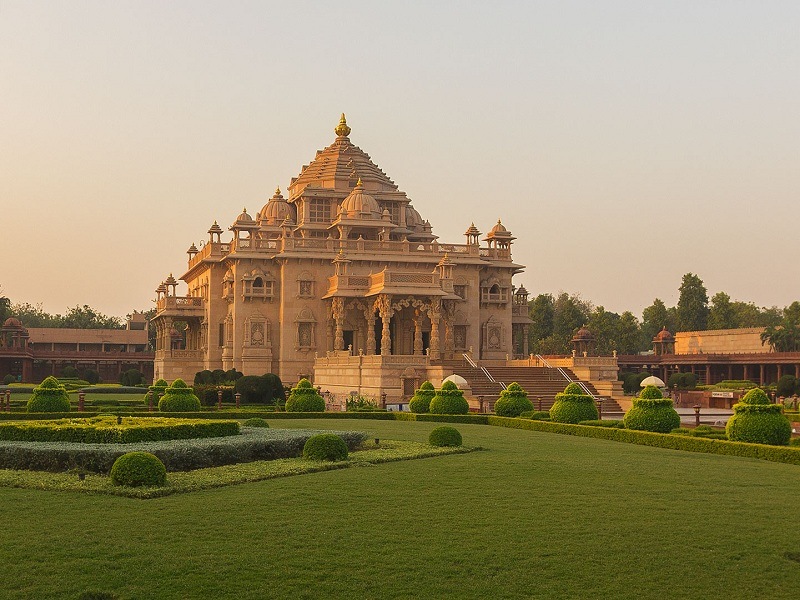



Leave a Comment